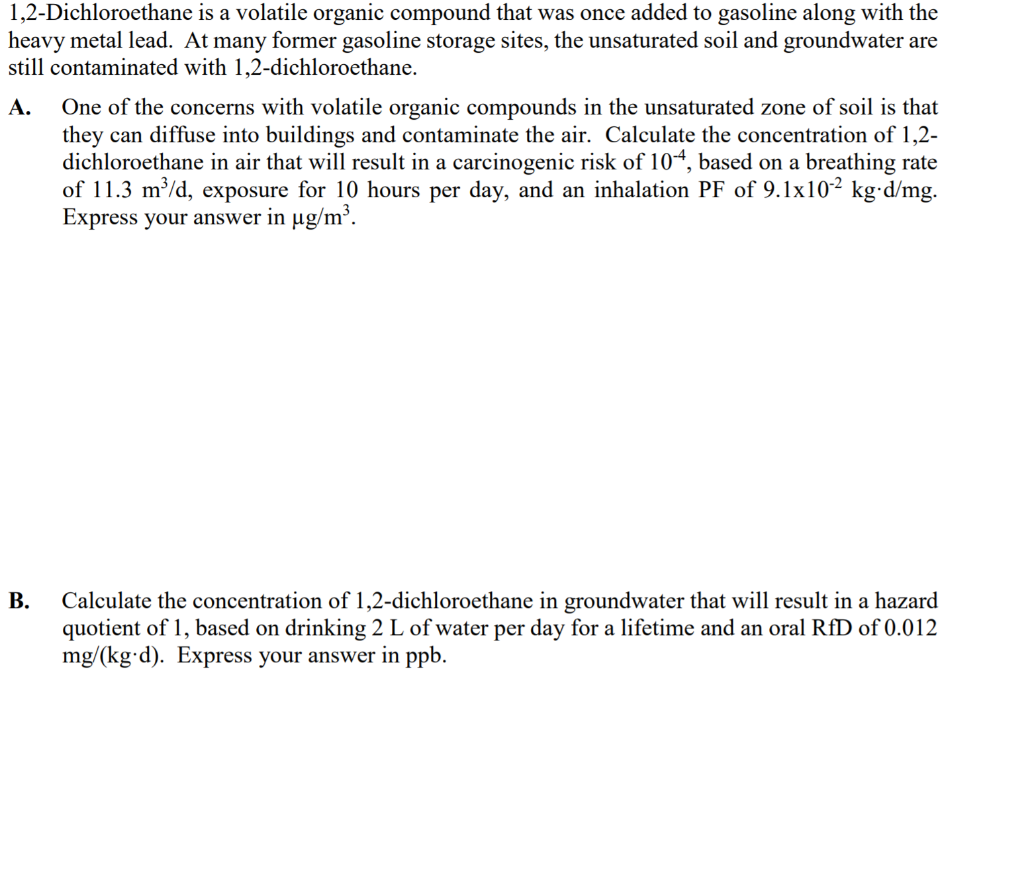1,2-Dichloroethane is a volatile organic compound that was once added to gasoline along with the heavy metal lead. At many former gasoline storage sites, the unsaturated soil and groundwater are still contaminated with 1,2-dichloroethane. One of the concerns with volatile organic compounds in the unsaturated zone of soil is that they can diffuse into buildings and contaminate the air. Calculate the concentration of 1,2- dichloroethane in air that will result in a carcinogenic risk of 104, based on a breathing rate of 11.3 m³/d, exposure for 10 hours per day, and an inhalation PF of 9.1x10-² kg•d/mg. Express your answer in µg/m³. A.
1,2-Dichloroethane is a volatile organic compound that was once added to gasoline along with the heavy metal lead. At many former gasoline storage sites, the unsaturated soil and groundwater are still contaminated with 1,2-dichloroethane. One of the concerns with volatile organic compounds in the unsaturated zone of soil is that they can diffuse into buildings and contaminate the air. Calculate the concentration of 1,2- dichloroethane in air that will result in a carcinogenic risk of 104, based on a breathing rate of 11.3 m³/d, exposure for 10 hours per day, and an inhalation PF of 9.1x10-² kg•d/mg. Express your answer in µg/m³. A.
Chemistry: Principles and Practice
3rd Edition
ISBN:9780534420123
Author:Daniel L. Reger, Scott R. Goode, David W. Ball, Edward Mercer
Publisher:Daniel L. Reger, Scott R. Goode, David W. Ball, Edward Mercer
Chapter16: Reactions Between Acids And Bases
Section: Chapter Questions
Problem 16.7QE
Related questions
Question

Transcribed Image Text:1,2-Dichloroethane is a volatile organic compound that was once added to gasoline along with the
heavy metal lead. At many former gasoline storage sites, the unsaturated soil and groundwater are
still contaminated with 1,2-dichloroethane.
One of the concerns with volatile organic compounds in the unsaturated zone of soil is that
they can diffuse into buildings and contaminate the air. Calculate the concentration of 1,2-
dichloroethane in air that will result in a carcinogenic risk of 104, based on a breathing rate
of 11.3 m/d, exposure for 10 hours per day, and an inhalation PF of 9.1x102 kg•d/mg.
Express your answer in µg/m³.
А.
Calculate the concentration of 1,2-dichloroethane in groundwater that will result in a hazard
quotient of 1, based on drinking 2 L of water per day for a lifetime and an oral RfD of 0.012
mg/(kg d). Express your answer in ppb.
В.
Expert Solution
This question has been solved!
Explore an expertly crafted, step-by-step solution for a thorough understanding of key concepts.
Step by step
Solved in 2 steps

Knowledge Booster
Learn more about
Need a deep-dive on the concept behind this application? Look no further. Learn more about this topic, chemistry and related others by exploring similar questions and additional content below.Recommended textbooks for you

Chemistry: Principles and Practice
Chemistry
ISBN:
9780534420123
Author:
Daniel L. Reger, Scott R. Goode, David W. Ball, Edward Mercer
Publisher:
Cengage Learning

Chemistry: Matter and Change
Chemistry
ISBN:
9780078746376
Author:
Dinah Zike, Laurel Dingrando, Nicholas Hainen, Cheryl Wistrom
Publisher:
Glencoe/McGraw-Hill School Pub Co


Chemistry: Principles and Practice
Chemistry
ISBN:
9780534420123
Author:
Daniel L. Reger, Scott R. Goode, David W. Ball, Edward Mercer
Publisher:
Cengage Learning

Chemistry: Matter and Change
Chemistry
ISBN:
9780078746376
Author:
Dinah Zike, Laurel Dingrando, Nicholas Hainen, Cheryl Wistrom
Publisher:
Glencoe/McGraw-Hill School Pub Co
